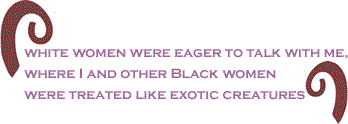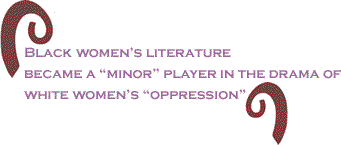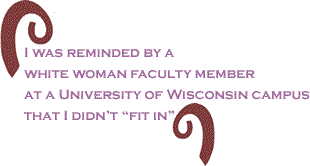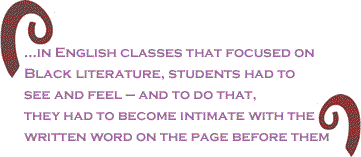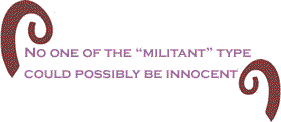
|
|||||||||||||||||||||
|
||||||||||
|
||||||||||
 |
||||||||||
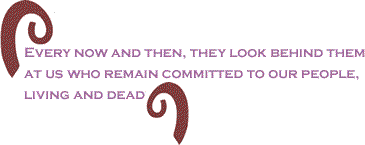 |
||||||||||
Whites in black face have returned to the stage — again. Every now and then, they look behind them at us who remain committed to our people, living and dead. They measure the distance between us. This time, they plan to remain on stage, in the spotlight, for they have been give leading roles in the U.S. Empire Agenda. Vital to this Agenda, these white liberals and so-called progressives serve the Master now in His program to maintain white dominance and suppress resistance. They are on the stage now. See them dangling gleefully beneath the strings? Vaudeville and the minstrel shows, where white entertainers covered their faces in black greasepaint, have moved to a new arena. Grease paint is obsolete there. The theft of a group’s heritage by another, the reading of our cultural texts in a way as to erase its ability to inform and empower, and the exclusion of individuals with the experience of racial oppression and resistance is a violence in proportion to the violence of invading Iraq for the purpose of bring “freedom” to that sovereign country. The theft of Black heritage solves the problem of guilt and fear. It solves the problem of confronting, as Toni Morrison has termed it, the “unspeakable” in one’s own heritage. Erase the narrative of oppression and resistance by taking hold of the cultural products, in particular Black literature. This is what is called “education” at these institutions of higher education. In recent years, the target of black face take over is Black feminism, as expressed in Black women’s literature. In general, Black literature is subversive in that its representations of oppression challenge the narrative of white innocence. Black women’s literature reflects this challenge as a practice of resistance, a practice of Black feminism. Black feminism, Mary Helen Washington writes, “calls us to community.” It “calls us to identify with the poor, the exploited, the powerless. Black feminisms are expressions of responsibility and accountability that place community as a cornerstone in the lives and works of Black females,” Joy James explains. James continues, "revolutionary black feminism transgresses corporate culture focusing on female independence; community building/caretaking; and resistance to state domination, corporate exploitation, racism, and sexism. Emphasizing economic and political power rather than social service programs for the disenfranchised, it challenged basic social tenets expressed in ‘law and order’ campaigns. It does not restrict itself to political dissent channeled through lobbying and electoral politics or accept the corporate state as a viable vehicle to redress disenfranchisement."
As a result, the struggles of Black feminist/writers are progressive struggles against racial, gender, and class inequality and injustice. “The utility of black feminisms in progressive movements,” James concludes, “is largely determined by their capacity to illustrate and analyze the intersections and multidimensionality of oppression and freedom.” "Contemporary Black women’s literature, however, entered the halls of higher education in the 1970s as a practice of resistance that recalled a long struggle with white supremacy, begun by ordinary enslaved Black women," Washington writes. I enter higher education, too, in the early 1970s. And while Black students were demand ing Black studies courses, the Black Panthers are extant, and we are wearing afros and Angela Davis buttons, passing frightened expressions of the faces of mostly older white male professors who warned that we would never complete our degrees. By the mid-1970s, in California, I remember white women were eager to talk with me, where I and other Black women were treated like exotic creatures. White women and some white men wanted to know how I had “escaped” the Black community. This was rather puzzling to me as I recall because I did not think, on the one hand, that I has “escaped” the Black community. I wore an afro; I was reading Morrison and Baldwin; and I still followed the FBI’s hunting down of Black Panthers. I had resisted repression to some degree, in that I managed to accomplish a college education. I was working as a reporter for a political, grassroots, city paper in Santa Monica. They wanted to know all about me and my personal struggles! Had I been abused by my father or perhaps boyfriend or boyfriends? Black men, they had heard, were after all a brutal lot. Was my mother an alcoholic or perhaps burdened down with children? Did I have to sleep two or three to a bed in a one-bedroom, rat and roach infested tenement building back in Chicago? Were the streets outside my one window filled with running or standing Black gangsters with guns shooting at anything that moved? Had I been on illegal drugs in order to cope with the burden of being a Black woman? They did not want to hear that my father and mother worked and that I attended catholic elementary and high school, but fought to attend a public school in the last two years because I did not want to further my high school education at a girls “finishing school.” They certainly were fascinated that I had a bachelor degree in, of all things, English! Eventually, it was all rather disturbing for them. They had a new nightmare to consider.
Black women, effectively carving a position space in the cultural milieu and in higher education, instituting Black Studies courses and installing Black women’s literature, darkened the lily-white decorum of these institutions. Not surprising, those white women who hadn’t confronted their own racism and capitulation to white supremacy or the privilege their race and class status afforded them, felt most threatened by the presence and focus on Black women thinkers and writers. They found in feminism, a way to challenge gender roles and adjust their collective class status, while Black women could not afford to focus on gender alone, as many white women would have preferred, nor could we consider class without race. “Class struggle in American society has been shaped by the racial politic of white supremacy;” writes hooks, and “it is only by analyzing racism and its function in capitalist society that a thorough understanding of class relationships can emerge. Class struggle is inextricably bound to the struggle to end racism.” For these white women in academia, black face was a way to escape their own guilt, and in keeping with white supremacy, stake out their own interests at these institutions of higher education. Women studies programs became a white woman’s enclave in which Black feminism was judged too radical and, therefore, irrelevant and Black women’s literature became a “minor” player in the drama of white women’s “oppression.” As a result, in the subsequent years, hooks writes, “the exclusionary practices of women who dominant feminist discourse have made it practically impossible for new and varied theories to emerge.” In the parlance of liberal individualism, to use bell hooks phrase, the specifics of Black oppression in the U.S. were absolved and replaced, figuratively speaking, with a “multicultural” gumbo of narratives that speak the “oppression” of everyone at once — even white people — who become victims, and survivors of domestic and political abuse. Multiculturalism and more recently “diversity” themes and schemes are mere asides to suggest a democratic reality that was oppression-free or at best oppression-lite since “everyone” became entitled to wear a black face, except those with Black faces. For a politically and culturally conscious Black woman in academia, being locked out is a way of being, in higher education. I was reminded by a white woman faculty member at a University of Wisconsin campus that I didn’t “fit in.” We can teach Black women’s literature or Black Diaspora Studies in black face… …But without the oppression… as I once said to another white woman chair who told me that she did not believe that only Black women were the authority on Black women’s literature. I responded by saying — “maybe you want the oppression too?” But there can be no backtalk, and so I became an example to others who might dare to stand straight and speak out. I had to be dehumanized to evoke hostility from students and to instill fear in other faculty. Joyce A. Joyce wrote about the appropriation of Black literature by some white aculty. Meanwhile, our ancestors, our heritage were slowly being devoured, as whites “treat black literature as if it were exclusively a system of linguistic signs divorced from feelings, meaning, and social or political relevance.” I was expected to discuss texts like Incidents in the Life of a Slave Girl, Beloved, Fire Next Time, or The Color Purple as if they represented a detached “system of linguistic signs.” It was a performance that required “intellectual detachment and no spiritual/emotional connection with the subject matter." Until then, neither my personal nor academic experience had prepared me for this stunning abuse of power. “A mob is not autonomous: it executes the real will of the people who rule the state,” James Baldwin observed. As I pondered how to remain responsible and accountable, how to maintain income, a woman alone, and how to juggle this absurd condition oppression, my chair announced that I was to “stay low key” and not bother him. I am the only Black on the English faculty, but I am placed two buildings away — out of sight, out of mind, while I am to remember student comfort in the classroom comes first. Tend to that business with all due seriousness. Abide by the dictates of our narrative and all will be fine. I was to become a mere prop for “diversity assessment” reports, so I was to behave in such a way so that others could relax in their new roles as representatives of the State.
After I graduated with my doctorate in 1996, I remember reading the debate about “authenticity” and “essentialism” — particularly, though not surprisingly, surrounding Black culture, and Black literature in general. The mainstream anti-radical and, therefore, anti-progressive narrative, spearheaded by white feminists, put the question of authenticity in the air. It landed on Black scholars who earnestly debated the issue and came to declare a truce — okay, some said, maybe authenticity or essentialism is bad! In the air came the word, again — universalism! Blacks experience “authentic” oppression in the U.S. The experience of this “authentic” oppression is nothing to trivialize, nor is it strictly in reference to enslavement and exploitation. While many of us Black feminists struggle to think and work within a transnational framework, in order to address oppression by state corporations throughout the Black Diaspora, we are witnessing the conquest of women’s studies programs in the academic and in the publishing and grant funding communities reject any discourse that addresses racial oppression as a legacy of enslavement and colonialism. No authentic feelings are needed! No authentic experiences are necessary except those we deem less painful, less threatening — perhaps the plight of those poor women of Nicaragua or Darfur! Black women, on the other hand, should be content with Oprah Winfrey and Whoopi Goldberg and Condi Rice! Oppression? No, there’s an abuse of the welfare system, young Black girls having babies, a lack of interest in education, and on and on. “Being oppressed means the absence of choices,” hooks writes. Black people and Black women in particular are often, and more often these days of the Reagan/Bush agenda, without choices. Not even the aftermath of Hurricane Katrina and damaged levees has challenged white liberals/progressive to recognize how their own complicity and often leadership at the institutional level has contributed to what has been unfolding in New Orleans and many other cities in the U.S. Those of us, like me, who came late to teaching in academia, were forced to tap dance around these new black faces. Who is speaking? “But he has such great imagery and it’s a classic!” Who is speaking? Who controls the narrative? “These are mandatory texts of a great tradition!” Who is speaking? What interests does this narrative serve? “It is the human experience we are after now. THE HUMAN EXPERIENCE. The universal experience!” What interests does this narrative representation of whiteness and of blackness serve? “Your tone of voice!” Yes, my tone of voice… “Is hostile!” Is hostile, of course! Back in the classroom, some faces are hostile and others have their heads together, chuckling, looking at me while I gather all my strength to deal with issues their parents and past teachers taught them to despise.
Why can’t you teach Virginia Woof or Margaret Atwood? In the new narrative of black face, I am not scripted to be angry. Black literature courses, in particular, became sites of fierce counter resistance on the part of white students, many of whom demanded to be allowed to disassociate the oppression (or that ugly feeling they felt within before they turned away from the texts or the Black teacher reading passages) and focus, instead, on a temporary and painless as possible voyage to the Black world. In a sociology department, for example, students and faculty might discuss statistics: the number of Blacks incarcerated or the number of Black enslave persons, even, on a given plantation — back in the day. In Music, students and faculty might stand around, if they so desired, and sing the lyrics to “Sweet Chariot, Swing Low,” but in English classes that focused on Black literature, students had to see and feel — and to do that, they had to become intimate with the written word on the page before them. It is much harder for white students to read and contemplate the image Sethe, Morrison’s character in Beloved, presents when she tells Paul D that in the barn that day, Schoolteacher and his nephews sold her milk! It is much harder for students to accept Lucy’s sassiness toward her benevolent employer, Mariah. Lucy, a “foreigner,” an African Caribbean with no money, no anything, is hired by “kind” Mariah and her husband Lewis. My students talked of Lucy’s insolence and “mistreatment” of Mariah who was “trying to be nice to her” — her — rhyming with ugh and sounding like dirt! It is harder for these students to believe Assata Shakur was “innocent” and wasn’t involved in the murder of that policeman. Last year, at yet another University of Wisconsin campus, a white male student laughed out loud in the large lecture hall when I read a passage from Assata’s autobiography in which she states that she was innocent. Black women and Black little girls are not generally associated with “innocence.” No one of the “militant” type could possibly be innocent. Often, these students prefer an “authentic” sexual thrill rather than endure an “authentic” perspective from inside oppression, by a Black professor. These students have become familiar with the minstrel show version of parading black characters on the stage before them for the sake of grabbing anecdotal-like episodes to explain why Blacks had not progressed (drugs, gang warfare, or sheer laziness) or to explain why racism was no longer a legitimate topic (“successful” flights from plantation to freedom or from city ghettos to the big life). The actual appearance of a Black faculty, specifically a woman, is entertaining to some students (I was taunted at one University of Wisconsin campus by students in a class chanting “Janet Jackson, Janet Jackson,” after the Super Bowl halftime breast exposure episode. In another class, students continued to call out Ronald Reagan’s name anytime I reminded them about the poor and working class. Yet four students went to the chair (who called me to her office, before the dean) to complain about my perceived “attitude” and this was just after the beginning of the semester!
The transgressive industrial complex, as I call it, not only benefits the U.S. economy but also contributes to the acceptance of counter resistance, that is, suppression of consciously Black (authentic as opposed to commodified, fake blackness) at institutions of higher education. “When young black males,” bell hooks has noted, “labor in the plantations of misogyny and sexism to produce gangsta rap, white supremacist capitalist patriarchy approves of the violence and materially rewards them.” I have had faculty follow behind me down hallways insisting that these rappers spoke for me and people like me who come from the “ghetto” — as we all come from the ghetto. Never mind the misogyny and sexism. Get with it! Worse, young whites believe they are taking a walk on the wild side — a walk into blackness in their transgressive attire and ipods filled with rap music. It’s a white liberal’s indulgence in Black culture. Get with it! It’s just white youth “playing” in the darkness of a narrative that speaks to the absence of racism and the by-gone era of segregation. And you agree, right? Look, they have accepted Black culture as a means of expressing themselves. Be grateful! Shake the “attitude! And go shop for an attire befitting these halls of academia! I cannot help but mention the young white male student who informed me one day that his baggy pants and cap was him! He was expressing himself. I am looking at this white face, free to speak this absurdity, while I have a muzzle on my Black face! The same young man had difficulty reading some chapters from Barbara Enrenreich’s Global Woman as these images of “nannies, maids, and sex workers in the new economy” contradicted the lyrics of Snoop Dog. In this atmosphere, there is not room for an expression of my frustration or outrage. Outrage on my part is condemned, as it represents a sign of my insanity! This hostile work space complies with the U.S. Empire’s new world order. Students have been impressed with corporate-produced images of Black woman as “mama,” bitch,” or "ex-ho," who probably “hangs out at night in the “hood” and probably takes a beating every now and then from her man, who shows her her place in this world — our world! White faculty chuckle and continue to mark their distance.
In higher education, the commodification of blackness is visible in the attire and music of white students while the whitening of blackness is part of the undercurrent, barely visible. Black students are, for the most part, urged to “middle-of-the-road,” go white, go mainstream. Attire, hair, and tone of voice attest to a desire to permanently accomplish nirvana — middle class or elite status. They are urged to look on Black professors who talk of race or oppression as old-timers, militants and, in this way, they often support the institutional structure that has no desire to educate them to know themselves, let alone express anything but gratefulness for the Mariahs and Lewises of the world, that is, grateful they can be color-blind. For these students, Black literature by Hurston, Walker, Morrison, Baldwin, and Ellison is counter-productive, an embarrassment and discussions on the legacy of enslavement and the new disenfranchised Black population are subjects far removed their world, for these are generally middle-class Black students who have been protected by their parents from experiencing the “authentic” oppression of racism. Some of these young Black college students, if they manage to avoid the grip of the prison industrial complex established for their benefit, are often treated to an education that is far from empowering. Worse, some of them will have lost their souls to the rhetoric of colorblindness and, in turn, speak out the loudest about Black faculty and their ranting and raving about race. Collectively, white and black students frown on my ignorance of rap or hip-hop artists while I am saddened by their inability to even name a Black author. My insistence on teaching Black women’s works and focusing on Black feminism meant that I would not “go-along-to-get-along.” My allegiance with the poor and working class represented my responsibility and accountability to parents and grandparents now dead and all those ancestors before them and the future generations of Blacks to come. And, of course, the narrative of innocence referenced this commitment as “crazy.” Where is she from? What does she possess? Crazy folks are those who enter the halls of higher education and who refuse to accept the status quo of elitism. I came to discover how “crazy” works in tandem with the role of the Black “mute.” "Basically in white culture,” hooks explains, “black women get to play two roles. We are either bad girls, the 'bitches,' the madwoman (how many times have you heard folks say that a particularly assertive black woman is 'crazy') seen as threatening and treated badly, or we are supermamas..." You can remain silent or mute; there are rewards for this “good” girl behavior. But if you speak, become visible, well, there’s punishment ahead for you. The Black feminist professor tap dancing among these students is acutely aware of the strings of corporations, government dollars, and wealthy parents making sure these educational institutions keep a big brother eye in her classrooms. This tap dancing represents the major difference between a white teacher, indoctrinated within the narrative of white supremacy, and who does not take hold of racism and its relationship with white privilege, and a teacher who experiences the “authentic” oppression of white supremacy. The former will not tread such dangerous waters. She, often, has no sense of something personal or publicly at stake while the latter has committed to be responsible and accountable to the living and the ancestral Black family. The latter cannot ignore race, particularly when she is experiencing social alienation from colleagues, white and Black, who have been warned about getting too close to the taboo, that Black woman and her subject of racial oppression — that “authentic” blackness that is not so easily commodified, cloned, because it is poisonous to the long term health of white hegemony.
Educators, scholars, and journalists like Tim Wise, David Roediger, Tim Tyson, or Barbara Ehrenreich are consciously aware of their role as resisters against white hegemony. They are practitioners of the pedagogy of the oppressed and, therefore, reject the narrative of color, gender, and class blindness. But as Larry Pinkney writes in We Beg Your Pardon America: Excuse Us While We Puke (BlackCommentator, Issue #243), these educators are brave, and therefore, “few and far between.” For those white faculty who engage in black face politics in higher education, however, teaching Black literary texts like Beloved or Praisesong for the Widow permits them to indulge in the “outlaw” behavior (a mirror reflection of Black women) but without repercussions. They can engage the taboo against association with blackness. Like vampires, they possessed Black women’s literature, draining the most dangerous elements from it, namely its representation of oppression and resistance, ensuring that Black literature remains mute and ineffective in its challenge to white supremacy. Allegiance to the U.S. Empire’s Agenda is the real game of “education” at these institutions. Therefore, to talk of white conservatives and liberals as if these were mutually exclusive entities is to ignore how both serve the same narrative, for their interests lie in maintaining white dominance. A certain mentality of false authority and arrogance connects the State with its educational institutions. Consequently, the shifty practice of inclusion (the Black face performances at the theatre of diversity) conceals a fierce desire for preservation of the ONE and the ONLY, a preservation long a tenet of imperial aggression to remove all traces of blackness from whiteness. This farcical representation of “diversity,” of black face performance, is but a progression toward absurdity. Like the flood waters of Katrina, they rush
in, flashing memories of something you have been running
from all your life. This is what we don’t want in our classrooms,
with our children, these painful jabs, floods of bad memories.
On the other hand, I can’t help but see the FBI’s Cointelpro program in the floating bodies of those victims of Katrina. Cointelpro never left; it has always been with us, in disguise, functioning under the watchful eyes of a new breed of conservatives and liberals, consciously or unconsciously on the corporate take. This new form of Cointelpro encourages classification, polarization, dehumanization, spying, humiliation, torture, and above all — denial. The narrative accommodates us – dead! America does not care about Black people.
A Black sister from a working-class family, working as an adjunct professor or Visiting Assistant Professor, receiving wages near the poverty level or, if full-time, wages still below my colleagues, and often without health insurance, I took the risk of being homeless at times and barely able to eat a full meal many days. "Some of us are from working-class backgrounds, which makes our struggle for radical black subjectivity unique and intense because we have no intention of breaking ties with the world we come from,” writes bell hooks. The “happiness” of an elite life in academia, however, was not my calling, and hopefully, it will not be the calling of other Black women behind me. I certainly could not see myself adopt the attitudes and beliefs of this cabal of liberals and their practice of dishonesty and hypocrisy. Not long ago, I watched Dr. Melissa Harris-Lacewell on Bill Moyers challenge the classification of Katrina victims as all poor. Most of the victims, she stated, were homeowners and mostly working-class citizens. She added that this fact was something the U.S. would prefer to repress by declaring that the Black people of New Orleans were all “project” residents. I was grateful for Dr. Harris-Lacewell’s attempt to teach the decidedly “ignorant.” In my experience, no matter how I clarified that I received a catholic school education, my family was a family of workers and they we did not live in the “projects” and our neighborhood during my childhood was not “the ghetto,” I was still labeled the woman from the “projects,” from the ghetto, from poor, poor, ignorant family and now without family, home, car — the accruements of middle-class status — all because I could not and would not conform, could not remain detached from — oppression! Times have changed since the mid-1970s. The pendulum has swung in their favor and they intend to take ever advance to make sure it does not swing back to the days when Blacks were visibly in the fight and it looked like we might be gaining ground. Self-determination, something for which we have been fighting since our inauguration of the progressive movement in the U.S., is at stake. The insurgence of “perpetrator perspective” in jurisprudence, according to Michael K. Brown and Martin Carnoy in White-Washing Race: The Myth of a Color-Blind Society, permits the Supreme Court to move “decisively to adopt a ‘perpetrator perspective’ on issues of race”: Adopting the perpetrator perspective means looking at contested race issues from the vantage point of whites. The "perpetrator perspective” in law, like the conservatives’ understanding of racism, is preoccupied with white guilt or innocence. It largely ignores whether people of color have suffered injury or loss of opportunity because of their race.
Just as the “law and legal institutions normalize white advantage by articulating and enforcing cultural norms, which help to maintain racial hierarchy in the United States,” the institution of higher education, too, marginalizes any appearance of race discourse by solidify these campuses within the “perpetrator perspective.” The oppressed perspective is outlawed while the practice of black face engages — outlawed blackness. This is the ultimate performance of the absurd! At the latest University of Wisconsin campus, I have been branded similarly to my enslaved ancestors, “blacklisted” in Madison by the liberal insurgence of McCarthyism — in the state of Senator Joe McCarthy. Therefore, I can no longer work within academia. Yet, as Pinkney reminds us in the Black Commentator, “we politically-conscious Black people and other people of color must never allow white America to succeed in culturally, physically, and politically annihilating us.” And now when it seems we are blanketed with this absurdity from above and below, left and right — look again toward the center stage. Almost invisible, but they are there still — our ancestors. See the pleading look on their faces as they look at us — not the outlandish black faces. We are the true faces of the progressive movement in the U.S. — always have been and always will be because in us, lives our ancestors and our future, our resistance to the absurdity of black face aggression. For another view of the education issue, check out Larry Pinkney's Keeping It Real column this week entitled: Academia, White Racism, and the Miseducation of Our Youth In America. BlackCommentator.com Columnist Dr. Jean Daniels writes a column for The
City Capital Hues in Madison Wisconsin and is a Lecturer
at |
||||||||||
| September
13, 2007 Issue 244 |
|
| Printer Friendly Version in resizeable plain text format format |
 |
 |
 |
| |
| |

























